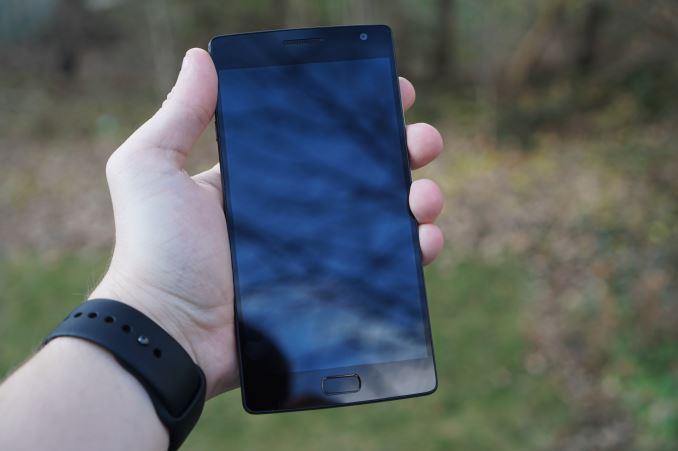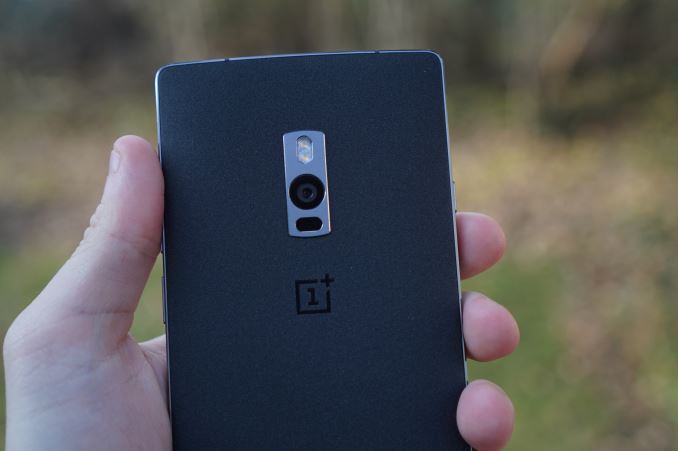The OnePlus 2 Review
by Brandon Chester on December 14, 2015 8:00 AM EST- Posted in
- Smartphones
- Mobile
- OnePlus
- OnePlus 2
Final Words
After using the OnePlus 2 for quite some time and going over the results of my testing, I can't say I'm thrilled with how things turned out for OnePlus's second smartphone. There are a lot of really odd regressions from the original, and when that's accompanied by an increase in price it makes me wonder why someone wouldn't seek out a OnePlus One, or a smartphone from a different vendor entirely. There were definitely some improvements over the OnePlus One as well, some of which are due to the changes in software that have been made since that time. Before making any conclusions, I'd like to go over the major aspects of the OnePlus 2 and see how they hold up to both the OnePlus One, and the rest of the competition in the increasingly competitive smartphone space.
Unfortunately, the OnePlus 2's display was one of the first things I realized represented a regression from the OnePlus One. Right when I started using the phone it was clear that the color rendition was not in line with what I have seen on recent smartphones. Measurements of the display confirmed that it's far too blue, and not accurate beyond matching the primary colors of the sRGB gamut. The substantial changes to the display characteristics that often come with OTA updates never actually improve the display in any meaningful way, and the fact that the accuracy is such an enormous regression from the OnePlus One is just completely unacceptable.
Performance is another area where the OnePlus 2 is extremely disappointing. Snapdragon 810's issues are well documented at this point, but the OnePlus 2 ends up being the worst implementation that I've seen, with the Cortex A57 cores never being used at all in circumstances like web browsing or when navigating the UI. It makes the phone feel like a Moto E, which is something I remarked on before even realizing exactly what was wrong with the CPU's behavior. When considering the performance of the OnePlus 2, it's more accurate to think of it as buying a quad core Cortex A53 device than a 4x4 Cortex A57 + Cortex A53 device.
Thankfully, it's not all bad news. While the performance is certainly not what you'd expect from the advertised specs, the phone gets pretty great battery life as a result. The construction of the phone is also quite good, with very few visible seams due to the type of back cover attachment method OnePlus has used. I'm still not a fan of the back cover material, but I recognize that as a very subjective feeling and so I wouldn't consider that as an aspect that is necessarily positive or negative. As for the camera, OnePlus has put some significant effort into improving their image processing, and there's no longer any issue with chroma noise across the frame even in broad daylight. I think OnePlus still has room to improve in this regard, particularly where noise reduction is concerned, but in its current state the OnePlus 2 produces fairly good photos considering its price tag.
Unfortunately, even with a decent camera, good battery life, and a nice chassis, the OnePlus 2 simply has too many flaws that can't be overlooked. Like the original, the OnePlus 2's tagline is "Never Settle". Unfortunately, the OnePlus 2 does make you settle in many ways. You have to settle for not having Quick Charge 2.0 support, and you have to settle for not having NFC which locks you out of Android Pay. You have to settle for a very poorly calibrated display which pales in comparison to the original. Most disappointing of all is that you have to settle for poor performance, when moving through the UI, browsing the web, and doing anything remotely CPU intensive. You have to settle for a great number of concessions, many of which didn't exist on the OnePlus One, and none of which should exist at this price point.
At $389, you can find much better smartphones, such as the Nexus 5X, or you can search for sales on phones like the Galaxy S6 or LG G4 if you're in a region where the Nexus phones end up being much more expensive than Google's price in North America. Even the OnePlus One would offer a better overall experience. Regardless of what your needs are when buying a smartphone, I think there will be better options available to you than the OnePlus 2.












132 Comments
View All Comments
tipoo - Monday, December 14, 2015 - link
It's basically running like a Snapdragon 410 on web browsing since it doesn't turn on the A57 cores? That's...Errm...Suboptimal. OnePlus did say they were sorting out the S810 throttling through software - I didn't think they meant by just not using the big cores!Granted, web browsing is so network bound with modern CPUs, maybe that's relatively ok as the wifi battery life is indeed decent.
tipoo - Monday, December 14, 2015 - link
Actually nevermind the last, as the author said it even felt slower. That's just screwey on Oneplus's side.tipoo - Monday, December 14, 2015 - link
"Even with that, it's not exactly clear to me what additional factors make the Snapdragon 808 and 810 devices all perform so poorly here compared to a device like the Moto G which just has 4 Cortex A53 cores. "Could there be any differences in how the SoC provides bandwidth to the A53s, since they're just backup in the 810 but the only CPUs in the 410? Are the cache configurations the same too?
lucam - Monday, December 14, 2015 - link
Dear Anand on regard to GPU performance, why don't you start using 3D Mark Slingshot which runs at 1080p and uses Open GL 3.0 rather than the Ice storm which starts to be old (720p, Open Gl 2.0).And for the GFXBench 3.0, maybe you can start using the 3.1 version of Manhattan as well, more intense. I believe you know there is the IOS version of Manhattan 3.1 as well now.
Ryan Smith - Monday, December 14, 2015 - link
All of our mobile benchmarks are set to be overhauled for 2016. We're just at the end of the year, so it's the latest point in the calendar.lucam - Monday, December 14, 2015 - link
Excellent!!tipoo - Monday, December 14, 2015 - link
(Anand doesn't work here anymore :P )lucam - Monday, December 14, 2015 - link
You are right and I've totally forgotten that :)Where is he actually?
Araa - Monday, December 14, 2015 - link
He works for Apple nowikjadoon - Monday, December 14, 2015 - link
I wonder if he is secretly responsible for the stellar sequential write performance on the iPhone 6 lineup.